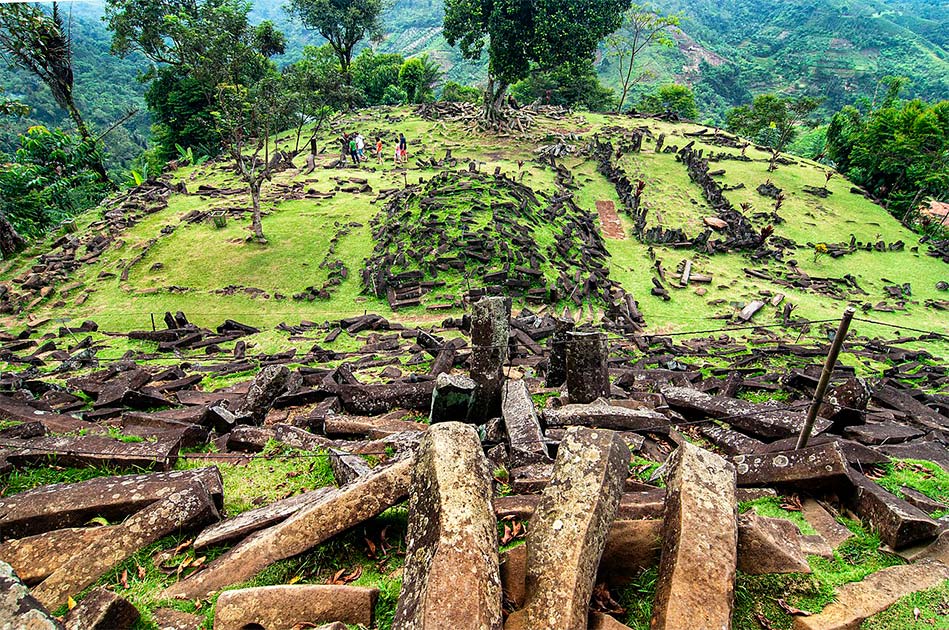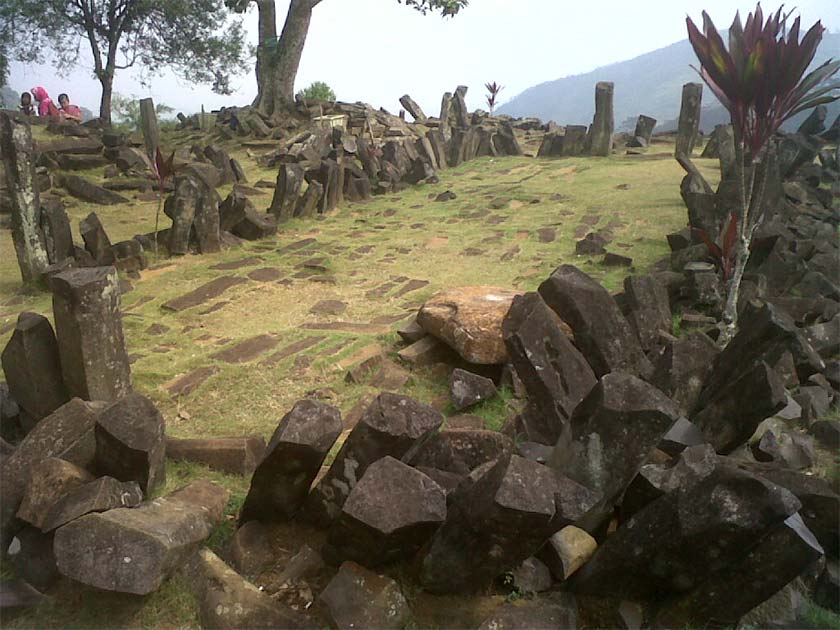Hidden amidst the lush landscapes of Indonesia lies a mysterious archaeological site that has ignited a storm of disagreement among researchers and history enthusiasts alike. Known as Gunung Padang, this amazing ancient site has become surprisingly controversial.
Indonesia’s government claims that it’s the oldest pyramid in the world, beating the pyramids of Giza by up to 15,000 years, and is proof of a previously unknown advanced civilization. Skeptics aren’t convinced, believing the site to be much younger and questioning whether it even counts as a pyramid at all.
What everyone can agree on is Gunung Padang raises more questions than it gives answers.
Gunung and Its History
Gunung Padang is a megalithic mystery that has captivated scholars, archaeologists, and historians since its discovery in 1890. What sets the site apart is its unique terraced structure. Thought to date back anywhere between 5,000-20,000 years ago, the structure is made up of a series of stacked stone layers situated on a hill.
When we say the structure is mysterious, we mean it. Gunung Padang’s history is a puzzle that archaeologists have been trying to assemble for over a century. Some have proposed that it once served as a megalithic burial ground while others believe it was a place of worship, acting as a shrine or altar.

We can be sure it was a place of great significance, the precision and sophistication of its stone terraces hint at a surprisingly advanced level of ancient engineering and construction techniques. Someone put a lot of effort into building Gunung Padang, and the techniques used challenge our understanding of the capabilities of early civilizations.
Research around the site has also been politicized, drawing into question the accuracy of some researcher’s findings. In 2018 an Indonesian geologist, Danny Hilman Natawidiaja, used radiocarbon dating to claim the site is up to 20,000 years old (making it the oldest pyramid in the world by a wide margin) and to suggest the existence of a previously unknown highly advanced lost civilization.
- (In Pics) Ancient and Everywhere: Pyramids Around the World
- The “Hand Made Mountain”: Cholula, the Largest Pyramid in the World
Indonesia’s president seized on this bold claim to set up a task force aiming to prove Indonesia was once home to such a civilization. This in turn led to 34 of Indonesia’s top scientists and researchers signing a petition questioning the motives of the government-sponsored research teams. As one archaeologist put it:
“In archaeology we usually find the ‘culture’ first … Then, after we find out the artifact’s age, we’ll seek out historical references to any civilization which existed around that period. Only then will we be able to explain the artifact historically. In this case, they ‘found’ something, carbon-dated it, then it looks like they created a civilization around the period to explain their finding.”
The Sundanese people of Indonesia’s Java island have their own explanation for who built the Gunung Padang. According to them, it was built as a result of King Siliwangi’s efforts to build a palace in one night. Siliwangi is a semi-legendary king of the Hindu Sunda Kingdom and there are countless legends and tales in the region of his exploits: another impossible quest was nothing new to him.
While it would be nice if they were right, there’s little historical evidence to back it up. Sadly, this sums up the current plight of Gunung Padang pretty accurately: lots of big claims, little hard evidence.
When Is a Pyramid Not a Pyramid?
Whether or not Gunung Padang is the world’s oldest pyramid has become more than a bit contentious. For a long time, conventional wisdom has been that the Pyramids of Giza are the world’s oldest pyramids, a title many archaeologists are unwilling to hand over to a new contender.
Gunung Padang may lack the conventional pyramid shape commonly associated with ancient Egypt, but the site’s age does set it apart. Radiocarbon dating suggests the site may date back anywhere from 5,000 to 20,000 years, depending on whose research you listen to.
If we ignore the more controversial figures and say Gunung Padang is 5,000 years old, then it is indeed older than the Pyramids of Giza which are around 4,500 years old (the oldest Egyptian pyramid, in the ancient necropolis of Saqqara, was built around 2630 BC by Pharaoh Djoser). This revelation has led to speculation that Gunung Padang could genuinely hold the title of the world’s oldest pyramid-like structure.
So why is this all so contentious? Radiocarbon dating makes it look like Gunung Padang is at least as old as the Egyptian pyramids, maybe even pipping Saqqara by a few centuries. The problem is lots of people aren’t happy with the pyramid designation at all.

This is the question experts need to answer if they’re going to classify Gunung Padang. It’s true that one has to really squint to make Gunung Padang look anything like a “traditional” pyramid. At a distance, it looks more like a hill with some old stone columns and terraces on top. It can be argued it is the hill, more than anything, that makes the site look like a pyramid.
Unlike the well-known Egyptian pyramids with their seemingly smooth, triangular sides converging to a pointed apex, Gunung Padang presents a stepped, terraced formation. On top of this, pyramids are usually free-standing while Gunung Padang is built into the side of a hill. This departure from the conventional pyramid design raises questions about whether it should be classified as a pyramid at all.
The debate about whether Gunung Padang is the world’s oldest pyramid isn’t likely to be settled any time soon. Firstly, a lot more archaeological research needs to be carried out at the site. Critics of Indonesia’s research teams have said more stratigraphy and radiocarbon dating needs to be carried out on the structure’s lower layers before a definitive date of construction can be decided.
Secondly, we need to decide what exactly counts as a pyramid. For Gunung Padang to be declared the world’s oldest pyramid, our understanding of exactly what constitutes a pyramid will likely need to evolve. But definitions have meaning, and the chances seem low that countless experts will be willing to rewrite the definition of a pyramid just so Indonesia can claim to have the world’s oldest.
And this debate really misses the point. Archaeology shouldn’t be about the oldest this or the biggest that. It doesn’t matter if Gunung Padang is the world’s oldest pyramid. It’s just a title. What matters is finding out more about who built it, how, and why. If Gunung Padang is evidence of a previously unknown, highly advanced ancient civilization, then whether it is a couple of centuries older than Egypt’s pyramids is not really the important thing.
Top Image: The Gunung Padang site is littered with dressed stone blocks which formed terraces. Source: Arie Basuki / CC BY-SA 4.0.